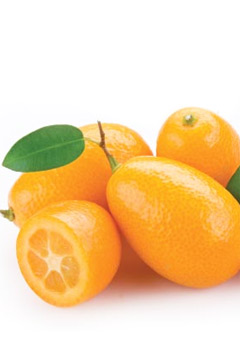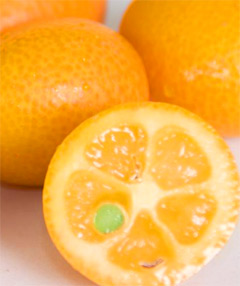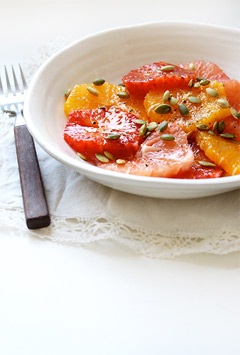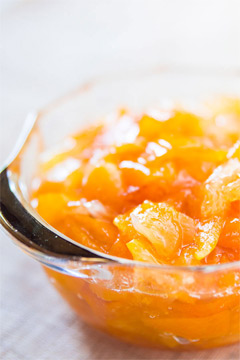|
|
Kumquat: Goldmine of Nutrition

Fortunella Japonica, most commonly known as Kumquat is one among the
remarkably diminutive members of the citrus family. It tastes sour with a dash
of sweetness. The juicy pulp of kumquat contains centrally placed tiny green
seeds that ought to be removed before consumption. Despite being extremely
small, this orange-like fruit is a goldmine of nutrition.
Kumquats or cumquats are a group of small fruit-bearing trees in the flowering
plant family Rutaceae, either forming the genus Fortunella, or placed within
Citrus sensu lato. The edible fruit closely resembles that of the orange (Citrus
sinensis), but it is much smaller and ovular, being approximately the size and
shape of a large olive. The English name "kumquat" derives from the Cantonese
pronunciation gam1 gwat1 (given in Jyutping romanization).
They are slow-growing evergreen shrubs or short trees, from 2.5 to 4.5 meters (8
to 15 ft) tall, with dense branches, sometimes bearing small thorns. The leaves
are dark glossy green, and the flowers are white, similar to other citrus
flowers, borne singly or clustered in the leaf-axils. Depending on size, the
kumquat tree can produce hundreds or even thousands of fruits each year.
The tree can be hydrophytic, grown in water, with the fruit often found floating
on water near shore during the ripe season.The plant is native to south Asia and
the Asia-Pacific region. The earliest historical reference to kumquats appears
in literature of China in the 12th century. They have long been cultivated in
India, Japan, Taiwan, the Philippines, and southeast Asia. They were introduced
to Europe in 1846 by Robert Fortune, collector for the London Horticultural
Society, and shortly thereafter into North America.
Carl Peter Thunberg originally classified the kumquats as Citrus japonica in his
1784 book Flora Japonica. In 1915, Walter T. Swingle reclassified them in a
segregate genus, Fortunella, named in honor of Robert Fortune. Seven species of
Fortunella have generally been recognized�F. japonica, F. margarita, F.
crassifolia, F. hindsii, F. obovata and F. polyandra, as well as the recently
described F. bawangica. The Flora of China returns the kumquat to Citrus and
combines the species into the single species as Citrus japonica.
Varieties of Kumquat
Round kumquat
 When the kumquats are divided into multiple species, the name Fortunella
japonica (or Citrus japonica) is retained by this group. The round kumquat also
called Marumi kumquat or Morgani kumquat, is an evergreen tree, producing edible
golden-yellow fruit. The round variety called "Meiwa kumquat" in Hawaii is
delicious raw. The fruit is small and usually round but can be oval shaped. The
peel has a sweet flavor but the fruit has a sour center. The fruit can be eaten
cooked but is mainly used to make marmalades and jellies. It is grown as an
ornamental plant and can be used in bonsai. The plant symbolizes good luck in
China and other Asian countries, where it is kept as a houseplant and given as a
gift during the Lunar New Year. Round kumquats are more commonly cultivated than
other species due to their cold tolerance. When the kumquats are divided into multiple species, the name Fortunella
japonica (or Citrus japonica) is retained by this group. The round kumquat also
called Marumi kumquat or Morgani kumquat, is an evergreen tree, producing edible
golden-yellow fruit. The round variety called "Meiwa kumquat" in Hawaii is
delicious raw. The fruit is small and usually round but can be oval shaped. The
peel has a sweet flavor but the fruit has a sour center. The fruit can be eaten
cooked but is mainly used to make marmalades and jellies. It is grown as an
ornamental plant and can be used in bonsai. The plant symbolizes good luck in
China and other Asian countries, where it is kept as a houseplant and given as a
gift during the Lunar New Year. Round kumquats are more commonly cultivated than
other species due to their cold tolerance.
Oval kumquat
When the kumquats are divided into multiple species, the name Fortunella
margarita (or Citrus margarita) is used for this group. The oval kumquat is also
called the Nagami kumquat. The unusual feature of the Nagami cumquat is in the
eating of the fruit. The fruit is eaten whole, skin and all. The inside is still
quite sour, but the skin has the sweeter flavour, when eaten together it
produces an unusual refreshing flavour. Fruit ripens mid to late winter and
always crops very heavily, making a spectacular display against the dark green
foliage. The tree is smaller growing and dwarf in nature, making it ideal for
pots and has even been used in bonsai.
Jiangsu kumquat
When the kumquats are divided into multiple species the name Fortunella obovata
(or Citrus obovata) is used for this group. The Jiangsu kumquat or Fukushu
kumquat bears edible fruit that can be eaten raw. The fruit can be made into
jelly and marmalade. The fruit can be round or bell shaped; it is bright orange
when fully ripe. It may be distinguished from other kumquats by its round
leaves. It is grown for its edible fruit and as an ornamental plant. It cannot
withstand frost.
Kumquats are cultivated in China, South Korea, North Korea, Taiwan, Southeast
Asia, Nepal, Japan, the Middle East, Iran, Europe (notably Corfu, Greece),
southern Pakistan, and the southern United States (notably Florida, Louisiana,
Alabama) and California.
They are much hardier than other citrus plants such as oranges. The 'Nagami'
kumquat requires a hot summer, ranging from 25 �C to 38 �C (77 �F to 100 �F),
but can withstand frost down to about -10 �C (14 �F) without injury. They grow
in the tea hills of Hunan, China, where the climate is too cold for other citrus
fruits, even the Mikan (also known as the Satsuma) orange. The trees differ also
from other citrus species in that they enter into a period of winter dormancy so
profound that they will remain in it through several weeks of subsequent warm
weather without putting out new shoots or blossoms. Despite their ability to
survive low temperatures, kumquat trees grow better and produce larger and
sweeter fruits in warmer regions. Kumquats do not grow well from seeds and so
are vegetatively propagated, using rootstock of another citrus fruit.
Uses of Kumquat
Culinary uses include candying and kumquat preserves, marmalade, and jelly.
Kumquats can also be sliced and added to salads. In recent years kumquats have
gained popularity as a garnish for cocktail beverages, including the martini as
a replacement for the more familiar olive. A kumquat liqueur mixes the fruit
with vodka or other clear spirit. Kumquats are also being used by chefs to
create a niche for their desserts and are common in European countries.
The Cantonese often preserve kumquats in salt or sugar. A batch of the fruit is
buried in dry salt inside a glass jar. Over time, all the juice from the fruit
is diffused into the salt. The fruit in the jar becomes shrunken, wrinkled, and
dark brown in color, and the salt combines with the juice to become a dark brown
brine. A few salted kumquats with a few teaspoons of the brine/juice may be
mixed with hot water to make a remedy for sore throats. A jar of such preserved
kumquats can last several years and still keep its flavor.
In the Philippines and Taiwan, kumquats are a popular addition to green tea and
black tea, either hot or iced.In Vietnam, kumquat bonsai trees (round kumquat
plant) are used as a decoration for the T?t (Lunar New Year) holiday. Kumquat
fruits are also boiled or dried to make a candied snack called m?t qu?t.
Variants of the kumquat are grown specially in India. The kumquat is celebrated
annually in Dade City, Florida, U.S.A. with the annual Kumquat Festival.
Health Benefits of Kumquat
-
 Increase Immunity: Kumquat contains an excellent source of Vitamin C. It
contains 43.9 mg/100g which fulfills 73% of the RDA (Recommended Daily
Allowance). Due to the rich source of Vitamin C, Kumquat increase immunity. So
it is beneficial to protect from cold, flu and common infections. Increase Immunity: Kumquat contains an excellent source of Vitamin C. It
contains 43.9 mg/100g which fulfills 73% of the RDA (Recommended Daily
Allowance). Due to the rich source of Vitamin C, Kumquat increase immunity. So
it is beneficial to protect from cold, flu and common infections.
-
Protect from Cancer: Kumquat contains a high amount of antioxidants like
Vitamin A, Vitamin C and Vitamin E. Along with these antioxidants, it contains a
good amount of phytonutrients flavonoids like carotene, tannin, zeaxanthin,
pectin, etc. Antioxidants and phytonutrients protect the body from oxygen free
radicals. Free radicals are produced due to oxidative stress. These free
radicals damage DNA of the cell and turns the normal cell into a cancer cell.
But antioxidants neutralize these free radicals and acts as a shield to protect
DNA from free radicals. Thus it is effective to protect from cancer.
-
Improve Cardiovascular Health: Eating kumquat lower cholesterol and
triglycerides in the blood. Thus it increases the flow of blood in the nervous
system and reduces the risk of stroke and heart attack. Kumquat contains a good
amount of potassium which increase the fluid level. Thus, it helps to maintain
blood pressure and heart rate. Also it contains a good amount of Omega 3 and
Omega 6. Thus it provides complete health benefits to the cardiovascular system.
-
Protect from Diabetes: Kumquat contains natural powerful antioxidants Vitamin
C which protects from free radicals and removes these free radicals from the
body. Thus it helps to protect from diabetes. Also, it contains a good amount of
dietary fiber, Omega 3 and Omega 6 which lower cholesterol and triglycerides in
the blood. Thus eating kumquat reduces the risk of developing Type 2 diabetes.
-
Protect from Inflammation: Kumquat is rich in phytonutrient, antioxidants and
tannins which proves effective to prevent inflammation caused due to free
radicals. Kumquat is also effective to prevent hardening arteries and protect
from Arthritis.
-
Prevent early Ageing: Kumquat is a rich source of antioxidant Vitamin A and
Vitamin C. It fulfills 73% of Daily recommended Vitamin C. Such a rich source of
antioxidants protect skin damage from free radicals. Recent studies have found
that eating food rich in antioxidants slow the ageing process.
-
Increase Blood production: Kumquat is the rich source of nutrient that is
required for the production of blood. It provides manganese, magnesium, copper,
iron and folate that are required for the formation of RBC. Also it contains
Vitamin C that increases iron absorbing capacity of the body.
-
Fasten Healing: Kumquat contains a good amount of Vitamin C that increases
healing capacity of the cell.
-
Improve Bone and Teeth health: Vitamin A is required for the development of
teeth and bone. Also, it contains calcium that strengthens bone and teeth.
-
Increase Energy: Kumquat is an excellent source of Riboflavin that is
required for the metabolism of carbohydrate, protein and fats. So it is
effective to provide instant energy. Also, it contains a good amount of
carbohydrate and calorie.
 Kumquats are low in calories (8 Kumquats have little more than 100 calories) and
they are full of antioxidants, vitamins, minerals (copper, calcium, potassium,
iron, selenium, zinc, manganeses), and lots of fiber. Kumquats have polyphenols
in them like green tea and beta-carotenes important for your immune system, and
even great zeaxanthines, and luteins that are important for eye health. Kumquats are low in calories (8 Kumquats have little more than 100 calories) and
they are full of antioxidants, vitamins, minerals (copper, calcium, potassium,
iron, selenium, zinc, manganeses), and lots of fiber. Kumquats have polyphenols
in them like green tea and beta-carotenes important for your immune system, and
even great zeaxanthines, and luteins that are important for eye health.
Kumquats contain vitamins A, B�s, C, and E which are important for keeping way
degenerative diseases. 200 grams of Kumquats will give you most of your daily
dietary needs of vitamin C. And Kumquats contain lots of B vitamins that are
important for energy and for boosting your metabolism and for keeping away
depression. Kumquats also contain Omega 3 and Omega 6 fatty acids like the ones
found in cold water fish that are important for cardiovascular health and for
preventing strokes.
Kumquats can improve wound healing, help prevent and reduce the severity of
colds and flues. And because of all the great antioxidants Kumquats can also
help prevent cancer and also lower the risk of hardening of the arteries and
reduce inflammation and arthritis. Kumquats lower cholesterol and triglycerides
too, and help with diabetes and improve respiratory system function. 2/3 of a
cup of Kumquats contains more protein than you get from a hand full of nuts. And
studies show that eating citrus like Kumquats can lower your risk of coming down
with mouth, stomach, and throat cancer by 50%.
Dated 07 February 2014
|
|
|
|
|









